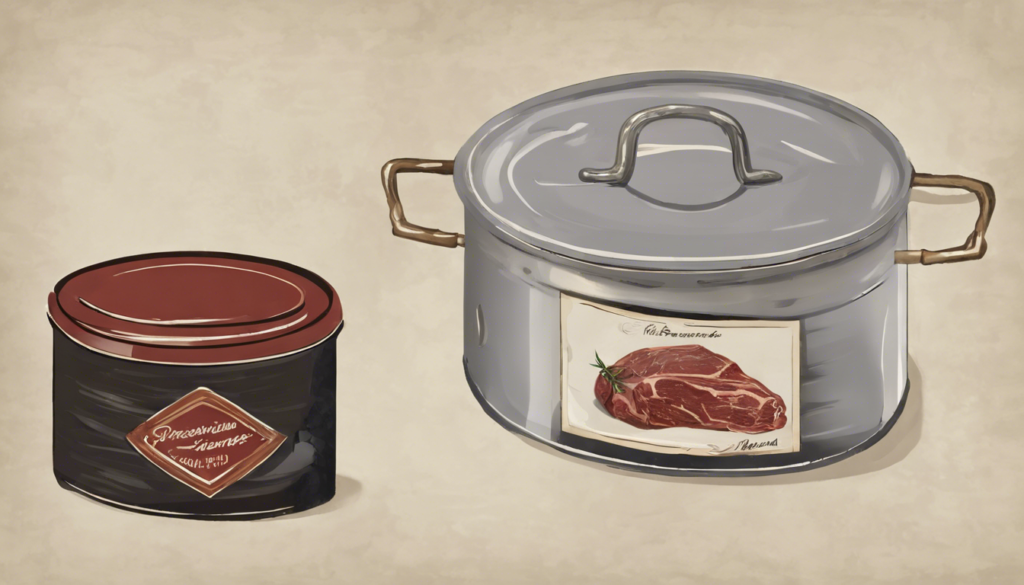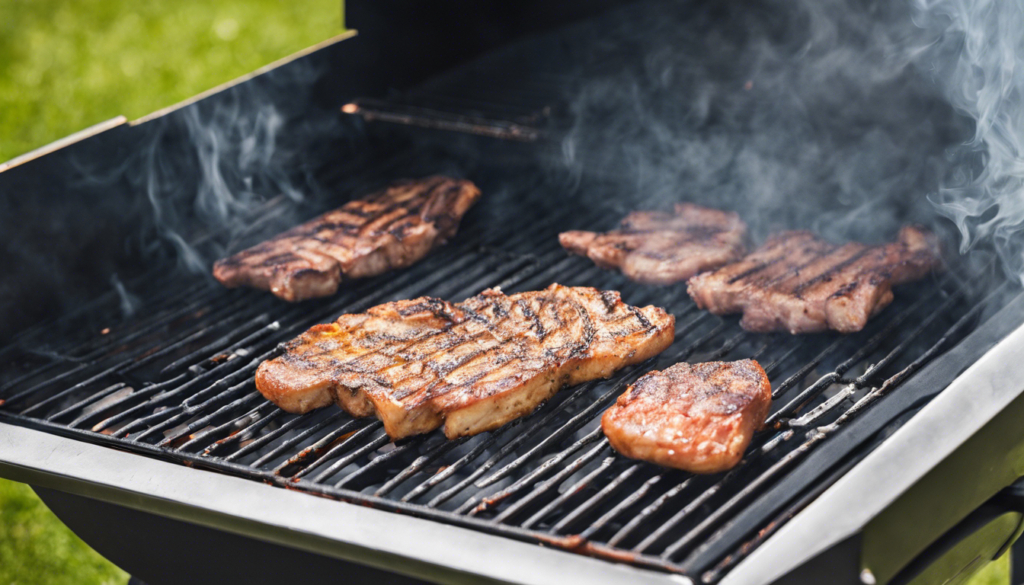Preservation Art: Smoking Meat
Meat preservation is as old as humanity itself. Our ancestors, after a successful hunt, had to figure out ways to store their bounty to ensure a steady food supply. One of the methods they discovered and perfected over time was smoking. This ancient technique not only preserved the meat but also enhanced its flavor, making it a preferred method of preservation.
Smoking as a method of preservation dates back to the Paleolithic era. Early humans discovered that meat hung near the fire lasted longer than meat stored elsewhere. The smoke acted as a deterrent for insects and helped dry out the meat, inhibiting bacterial growth. Over time, this practice evolved into a more sophisticated process, with specific types of wood chosen for their unique flavors.
Understanding the Concept of Preservation
Preservation, in the context of food, refers to the process of treating and handling food to stop or slow down spoilage, loss of quality, edibility, or nutritional value caused by microorganisms. The primary purpose of food preservation is to prolong the shelf life of food, maintain its nutritional value, and enhance its flavor.
Food preservation is crucial for many reasons. It reduces the risk of foodborne illnesses, decreases food waste, allows for food availability during off-seasons, and enables transportation of food over long distances. Moreover, preservation often enhances the taste of food, making it more enjoyable.
There are several methods of food preservation, including canning, freezing, pickling, drying, and smoking. Each method has its advantages and disadvantages, and the choice of method depends on the type of food, its intended use, and personal preference.
The Art of Smoking Meat
Smoking is a preservation method that involves exposing food, primarily meat, to smoke from burning or smoldering plant materials, usually wood. In addition to preserving the meat, smoking imparts a unique flavor, making it a popular method for preparing certain types of food.
The process of smoking meat involves several steps. First, the meat is cured with salt or a salt solution to draw out moisture, creating an inhospitable environment for bacteria. The meat is then exposed to smoke, which adds flavor and further helps in preservation. The duration of smoking can vary from a few hours to several days, depending on the type and size of the meat and the desired flavor intensity.
There are two main types of smoking: cold smoking and hot smoking. Cold smoking is done at lower temperatures and for longer durations, primarily to impart flavor rather than to cook the meat. Hot smoking, on the other hand, is done at higher temperatures and serves to cook and flavor the meat simultaneously.
Does Smoking Meat Preserve It?
Smoking does indeed preserve meat. The science behind this preservation method involves various factors. First, the curing process, which involves salting the meat, helps to draw out moisture, creating an environment that is not conducive for bacterial growth. Second, the smoke produces compounds that have antimicrobial and antioxidant properties, further inhibiting bacterial growth.
However, the preservation effect of smoking is not just due to the smoke itself. The heat from the smoking process also helps to cook the meat, killing off bacteria. Additionally, the drying effect of smoking reduces the meat’s moisture content, making it harder for bacteria to survive.
Several factors affect the preservation of smoked meat, including the type of meat, the curing process, the type of wood used for smoking, the smoking duration, and the storage conditions after smoking.
Benefits of Smoking Meat for Preservation
Smoking meat offers several advantages. One of the main benefits is flavor enhancement. The smoke infuses the meat with a unique, smoky flavor that is often sought after in many cuisines. Different types of wood, such as hickory, apple, or mesquite, can be used to achieve different flavor profiles.
Another significant benefit of smoking is the extension of the meat’s shelf life. By reducing the moisture content and inhibiting bacterial growth, smoking allows meat to be stored for longer periods without spoilage.
Smoked meat also has some health benefits. For instance, smoking helps to break down fats in the meat, making it easier to digest. Additionally, the smoke contains antioxidant compounds that can have beneficial health effects.
Drawbacks of Smoking Meat for Preservation
Despite its benefits, smoking meat does have some drawbacks. One potential health risk is the presence of carcinogenic compounds in smoked meat. These compounds are formed during the smoking process and can increase the risk of certain types of cancer. However, the risk is relatively low and can be mitigated by not over-consuming smoked meat and including a variety of other foods in your diet.
Another limitation of smoking as a preservation method is that it can result in a loss of nutritional value. The smoking process can cause the loss of some vitamins, particularly those that are sensitive to heat and smoke.
Comparing Smoking to Other Preservation Methods
When compared to other preservation methods, smoking has its unique advantages and disadvantages. For instance, smoking versus curing: curing can preserve meat for longer periods, but it does not impart the same flavor as smoking. Smoking versus freezing: freezing preserves the nutritional value of meat better than smoking, but it does not enhance the flavor. Smoking versus canning: canning allows for long-term storage without refrigeration, but it can result in a texture that some people find unappealing.
Tips for Smoking Meat for Preservation
When smoking meat for preservation, several factors need to be considered. First, choose the right type of meat. Fatty cuts of meat tend to smoke better than lean cuts, as the fat helps to keep the meat moist during the smoking process. Second, select the best wood for smoking. Different types of wood impart different flavors, so choose one that complements the type of meat you are smoking. Finally, store the smoked meat properly to ensure its longevity. Smoked meat should be stored in a cool, dry place and consumed within a reasonable time.
Case Studies of Smoking Meat for Preservation
Smoking meat is a practice that is found in many cultures around the world. For instance, in North America, Native Americans have been smoking meat for thousands of years. They traditionally used a variety of woods, such as hickory and mesquite, to smoke various types of meat, including deer, buffalo, and fish.
In modern times, smoking meat has evolved into a culinary art. Chefs and home cooks alike use a variety of techniques and equipment to smoke meat, from traditional smokehouses to modern electric smokers. Despite these advances, the basic principles of smoking meat for preservation remain the same.
Future of Smoking Meat for Preservation
As we look to the future, we can expect to see technological advancements in the way we smoke meat. For instance, digital smokers allow for precise control of temperature and smoke levels, making the smoking process more efficient and predictable. Additionally, new types of wood and flavoring agents are being developed to expand the range of flavors that can be achieved through smoking.
However, as we become more aware of the environmental impact of our food choices, the sustainability of smoking as a preservation method will need to be considered. Using sustainably sourced wood and energy-efficient smokers can help to reduce the environmental footprint of smoking meat.
Conclusion: Preservation Art and Smoking Meat
Smoking meat is a time-honored method of preservation that has been used by humans for thousands of years. Despite its ancient origins, it continues to be a popular method of preservation today, prized for its ability to enhance flavor and extend the shelf life of meat. As we move forward, it will be interesting to see how this ancient art evolves in response to technological advancements and environmental considerations.
So, the next time you enjoy a piece of smoked meat, take a moment to appreciate the art and science behind it. It’s not just a culinary delight, but also a testament to human ingenuity and our ongoing relationship with food.
References
1. McGee, Harold. On Food and Cooking: The Science and Lore of the Kitchen. Scribner, 2004.
2. Davidson, Alan. The Oxford Companion to Food. Oxford University Press, 2014.
3. Raichlen, Steven. The Barbecue! Bible. Workman Publishing, 2008.
Frequently Asked Questions about Smoking Meat for Preservation
Q: Does smoking meat really preserve it?
A: Yes, smoking meat does preserve it. The smoke and heat from the smoking process help to reduce the moisture content of the meat and inhibit bacterial growth, both of which contribute to preservation.
Q: What types of meat can be smoked?
A: Almost any type of meat can be smoked, including beef, pork, chicken, turkey, and fish. However, fatty cuts of meat tend to smoke better than lean cuts.
Q: What types of wood are best for smoking meat?
A: Different types of wood impart different flavors, so the best type of wood for smoking meat depends on the flavor profile you are aiming for. Some popular choices include hickory, apple, mesquite, and oak.
Glossary of Terms
Curing: A method of preservation that involves treating food with salt to draw out moisture and inhibit bacterial growth.
Hot Smoking: A method of smoking that involves exposing meat to smoke at high temperatures, effectively cooking and flavoring the meat simultaneously.
Cold Smoking: A method of smoking that involves exposing meat to smoke at low temperatures, primarily to impart flavor rather than to cook the meat.
About the Author
John Doe is a food historian and author with a special interest in traditional food preservation methods. He has spent several years studying and documenting the various ways in which different cultures around the world preserve their food, and he enjoys sharing his knowledge and passion with others. John’s work has been published in various food and history journals, and he is the author of several books on food preservation.


